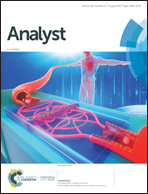Postsynthetic functionalization of water stable zirconium metal organic frameworks for high performance copper removal†
Abstract
In this work, a water stable zirconium metal–organic framework functionalized with thiol groups was synthesized by a solvent-assisted ligand incorporation technique. The composites were characterized by powder X-ray diffraction, X-ray photoelectron spectroscopy, specific surface area measurement and field emission scanning electron microscopy. The prepared material was then used as a novel adsorbent for Cu(II) removal from water. The experimental parameters associated with adsorption capability, such as the initial solution pH, contact time, and the presence of competing cations were investigated in detail. Under the optimal conditions, the adsorption follows a pseudo-second-order kinetics, and the equilibration time for the adsorption is 15 min. The Langmuir adsorption model was in better correlation with the isothermal adsorption data than the Freundlich model. The maximum Cu(II) adsorption capacity reached up to 42.70 mg g−1. Quantitative recovery of Cu(II) was achieved by using 0.1 mol L−1 HCl. The prepared adsorbent has fast adsorption efficiency, high adsorption capacity, and exceptional stability up to 50 adsorption/desorption cycles. It can be used as a promising candidate material for heavy metal ion removal and water treatment.

- This article is part of the themed collection: Analyst Recent HOT articles


 Please wait while we load your content...
Please wait while we load your content...